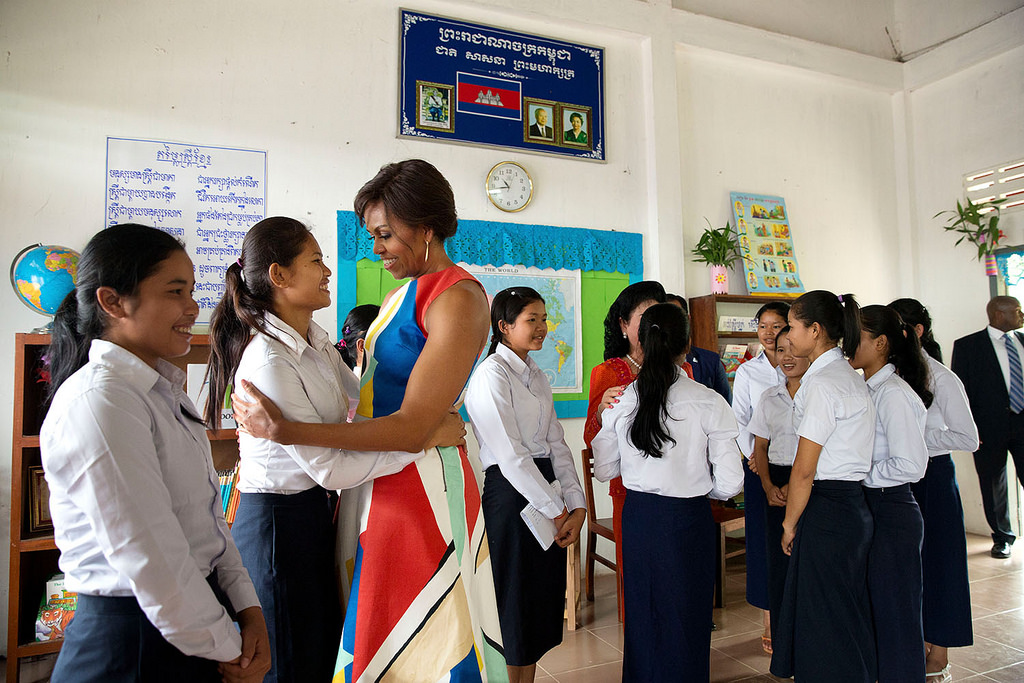 Let Girls Learn Initiative | Photo: Amanda Lucidon, Official White House Photo
Let Girls Learn Initiative | Photo: Amanda Lucidon, Official White House Photo
How Improving Gender Inequality Benefits Climate Action
Climate change disproportionately affects women. Of the 1.3 billion people living in poverty globally, 70% are women. Those in poverty are more readily and severely impacted by the effects of climate change, and women and girls are often the hardest hit following disasters. The United Nations (UN) found that climate events also make women more vulnerable to violence. In the Asia-Pacific region, sex trafficking spiked following cyclones and typhoons. Similar patterns were observed in several African, Latin American, and Central Asian countries as intimate partner violence rose during drought season. The cause is often due to movement into refugees or displaced persons camps or containment at home during a climate crisis. Climate-related events have also increased the rate of child marriages, as exacerbated poverty following a crisis encourages families to marry off their daughters, often with hope for a better future or for a to help the family.
Previous work by the American Security Project identified the unequal impact food and water scarcity from climate change has on women and the fact that women are often the first to lose their job following a climate crisis. Addressing the inequality women face due to changes in climate and becoming more climate-resilient go hand in hand, as addressing inequalities directly benefits climate action.
Addressing Women’s Inequalities to Improve Climate Resiliency
Education
The interconnected nature of climate action and women’s equality makes increasing women’s access to opportunities an essential avenue for changing the climate trajectory. Improvements in education for women and girls effectively combat climate change. Greater access to education results in more women in the climate-related decision process– an essential factor for viable and inclusive climate policy as women make up half of the population—and with more minds involved, increases in green technological innovations are more likely.
A Malala Fund report found that education helps women more readily overcome the shock of climate disasters, as they develop skills for a broader range of work options and learn to lead. The report found that if 70% of women ages 20-39 received at least lower-secondary education, disaster-related deaths could decrease by 60% from 2013-2050. STEM education (Science, Technology, Engineering, and Math) contributes to a low-carbon economy, thus encouraging women to pursue STEM ensures a larger workforce and pool of innovators to create green technologies. The report also found a correlation in countries with high rates of gender equality also having high rates of environmental well-being, further highlighting the positive impact women’s education has on climate resilience.
Sexual and Reproductive Health
Education and services on sexual and reproductive health is a proven strategy for decreasing vulnerabilities to climate change. Violations against women were less likely during or following a climate crisis in regions where rights on sexual and reproductive health were taught. Education in body autonomy and family planning slows population growth thus slowing the growth rate of greenhouse gas emissions.
Agriculture
According to the UN, providing women with the same access to resources as men results in more efficient agriculture, which can increase agricultural output by 20-30% and in turn lower the hungry population by 12-17%. Improving access to better production resources also means more access for women to sustainable technologies, further advancing their use. More sustainable agriculture also makes people more resilient to the impacts of a climate event affecting crops.
How is the World Addressing This?
The United Nations recognized “achieving gender equality and empowering all women and girls” in its Sustainable Development Goals (SDGs) to successfully end poverty and protect the planet. In the United States, President Biden put forth a National Strategy on Gender Equity and Equality including climate change as an interconnected issue. Across the world, only 15 out of the 160 Nationally Determined Contributions (NDCs) to the Paris Accords on Climate Change recognize the role of women’s equality, and only Cambodia and the United Kingdom include the context of education for girls.
The Future
Climate change has progressed considerably, and humanity is unlikely to reverse current trends anytime soon. With no changes the world is expected to warm by 1.5 degrees Celsius by 2040. With that warming comes more costly and deadly droughts, floods, sea-level rise, and storms. As such, solutions for climate action are essential. Addressing women’s inequalities is an effective and crucial step to enhancing climate resilience because it results in more representation in climate leadership, improved green technology and climate management, and reduced emissions.





